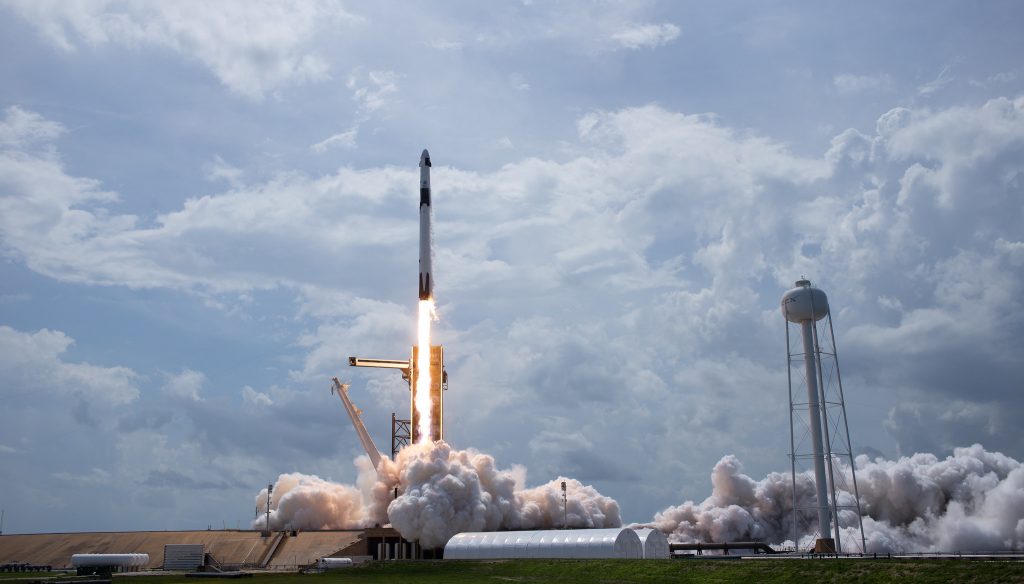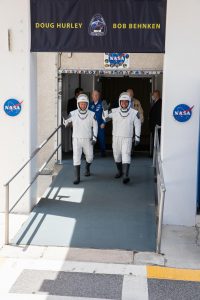
The SpaceX Falcon 9 rocket carrying NASA astronauts Robert Behnken and Douglas Hurley aboard the company’s Crew Dragon spacecraft launched from Kennedy Space Center’s historic Launch Pad 39A at 3:22 p.m. EDT. NASA’s SpaceX Demo-2 mission to the International Space Station is a critical final flight test of the SpaceX crew transportation system.
Today’s launch also marks the start of the commercial crew era of U.S. human spaceflight.

“What a great day for NASA, what a great day for SpaceX, and what a great day for the United States of America,” said NASA Administrator Jim Bridenstine. “It’s been nine years since we’ve launched American astronauts on American rockets from American soil, and now we have done it again.”
“I’d like to just acknowledge the incredible work of the people at SpaceX and NASA and everyone who created this technology – what has culminated in this incredible launch today, getting astronauts back to orbit after almost a decade,” said Elon Musk, SpaceX chief engineer. “We need to bring them back safely, and we need to repeat these missions and have this be a regular occurrence. There’s a lot of work to do.”
The countdown proceeded smoothly throughout the day, with the SpaceX Falcon 9 rocket and Crew Dragon spacecraft in good health and the astronauts ready to fly. The wild card – weather — was out of the teams’ control. Today’s liftoff was the mission’s second launch attempt; the first try, on Wednesday, May 27, ended up rescheduled due to unfavorable weather conditions.
At first, today appeared to be setting up with the same issues: rain, electricity in the atmosphere, cumulus clouds.
“We looked at the weather. It didn’t look great, but we looked at the different options that were out there, and we realized how important it was to step through this carefully, weigh the readiness of the hardware and very carefully assess the situation, and be able to clear the gates and milestones along the way,” said Kathy Lueders, manager of NASA’s Commercial Crew Program.
Late in the countdown, Launch Weather Officer Mike McAleenan with the U.S. Air Force 45th Weather Squadron reported conditions were “go.” The remaining countdown milestones ticked by quickly, and at 3:22 p.m. EDT, the Falcon 9’s nine Merlin engines ignited. NASA’s SpaceX Demo-2 mission was underway.
The Falcon 9 and Crew Dragon performed well on the climb to orbit, and the spacecraft separated from the rocket on time, about 12 minutes into the flight.
“Dragon, chief engineer on Dragon-to-Ground,” SpaceX Chief Engineer Bala Ramamurthy called up to the crew following Crew Dragon spacecraft separation. “Bob, Doug, on behalf of the entire launch team, thanks for flying with Falcon 9 today. We hope you enjoyed the ride and wish you a great mission.”
Behnken replied, “Thanks, Bala. Congratulations to you and the entire team on the first human ride for Falcon 9. And it was incredible. Appreciate all the hard work and thanks for the great ride to space.”
“Proud of you guys and the rest of the team,” Hurley added. “Thank you so much for what you’ve done for us today, putting America back into low-Earth orbit from the Florida coast.”
Having arrived in orbit, Crew Dragon began a 19-hour pursuit of the station, beginning with a phase burn and the mission’s first manual flight test.
“Bob and Doug are already up there accomplishing a lot of the goals of our test mission,” Lueders said. “They got to do their far-field [manual flight] demonstrations. They got to feel what it’s like to use the touchscreens in zero-G. They got to check out all the different parts of the system and liberate their zero-G indicator.”
Crew Dragon will perform a series of phasing maneuvers to gradually approach and autonomously dock with the International Space Station on Sunday, May 31, at approximately 10:29 a.m. EDT.
After a successful docking, hatches between the two spacecraft will be opened at about 12:45 p.m. Crew members Douglas Hurley and Robert Behnken will be welcomed aboard the International Space Station and become members of the Expedition 63 crew. Behnken and Hurley will perform tests on Crew Dragon in addition to conducting research and other tasks with the space station crew.
“Today onboard the [station], the three crew members, Chris Cassidy, Ivan Vagner and Anatoly Ivanishin, are getting ready to have their additional crewmates onboard,” said Kirk Shireman, manager of NASA’s International Space Station Program. “I know they’re very, very excited. There’s lots of work to be done on ISS and I know Bob and Doug, together with the folks on orbit, are really ready to get busy.”
Behnken and Hurley spent years training and taking part in the development of the SpaceX crew transportation system prior to today’s launch.
“I have never seen a crew so calm and focused leading up to a launch as these two were,” said NASA Chief Astronaut Pat Forrester, who has lived with the Demo-2 crew in quarantine inside Kennedy Astronaut Crew Quarters for the past several days. Forrester acknowledged their training and experience certainly played a role in their demeanor, but he believes their calmness also derived from confidence in the teams.
“I really think it’s a demonstration of the trust they had both in the NASA team and the SpaceX team to get them safely to orbit,” he said.
Demo-2 is SpaceX’s final test flight to validate its crew transportation system, including the Crew Dragon, Falcon 9, launch pad and operations capabilities. During the mission, the crew and SpaceX mission controllers will verify the performance of the spacecraft’s environmental control system, displays and control system, maneuvering thrusters, autonomous docking capability, and more.
The Crew Dragon being used for this flight test can stay in orbit about 110 days, and the specific mission duration will be determined once on station based on the readiness of the next commercial crew launch. The operational Crew Dragon spacecraft will be capable of staying in orbit for at least 210 days as a NASA requirement.
At the conclusion of the mission, Behnken and Hurley will board Crew Dragon, which will then autonomously undock, depart the space station, and re-enter Earth’s atmosphere. Upon splashdown off Florida’s Atlantic coast, the crew will be picked up by the SpaceX recovery ship and returned to the dock at Cape Canaveral.
“I am so grateful and proud of our NASA and SpaceX team,” Lueders said. “We’re going to stay vigilant until we bring them safely home.”
Keep up with mission milestones as they unfold on NASA’s International Space Station Blog at https://blogs.nasa.gov/spacestation.
NASA’s Commercial Crew Program is working with SpaceX and Boeing to design, build, test and operate safe, reliable and cost-effective human transportation systems to low-Earth orbit. Both companies are focused on test missions, including abort system demonstrations and crew flight tests, ahead of regularly flying crew missions to the space station. Both companies’ crewed flights will be the first times in history NASA has sent astronauts to space on systems owned, built, tested and operated by private companies.
Learn more about NASA’s Commercial Crew program at https://www.nasa.gov/commercialcrew.
